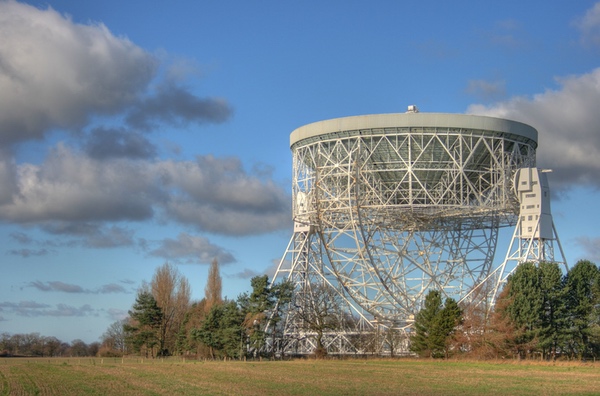The Missing Link: Foundby Dwayne A. Day
|
| It was long rumored that it also played a role in collecting intelligence on other Soviet spacecraft and had a connection to GCHQ, the United Kingdom’s signals and communications intelligence agency. |
Jodrell Bank was truly unique during the first decade or so of the space age because although it was a British facility that occasionally listened in on Soviet spacecraft, the Soviet Union and its allies also sent researchers there, and even asked for assistance in detecting their own spacecraft. The observatory played a role in both Cold War competition and cooperation. But it also had a darker, more mysterious side.
The radio telescope once famously scooped the Soviets on their own lunar mission, publicly releasing an image from a Soviet spacecraft before the Soviet government did. They accomplished this with the help of a photo scanner loaned by a newspaper. Although Jodrell Bank’s role in listening in on Soviet scientific spacecraft was publicly acknowledged during the Cold War, it was portrayed as a civilian effort. But it was long rumored that it also played a role in collecting intelligence on other Soviet spacecraft and had a connection to GCHQ, the United Kingdom’s signals and communications intelligence agency, the equivalent to the United States’ National Security Agency (NSA).
The Cold War Conversations Podcast has existed since 2018, with more than 330 episodes so far. It is an oral history project hosted by Ian Sanders, who interviews a wide range of participants in the Cold War, from tank commanders to pilots to intelligence officers to spies to defectors and people who experienced the Cold War from unique perspectives. A recent episode focused on Jodrell Bank. In it, Sanders met with Tim O’Brien, a professor of astrophysics and an associate director of the Jodrell Bank Centre for Astrophysics at the University of Manchester. O’Brien took him around the non-public areas of the observatory and explained some of its history. Professor Bernard Lovell built the observatory up in the post-war years, in part by scavenging electronic equipment from Britain’s demobilizing military. He also successfully obtained government funding to expand the observatory throughout the 1950s. O’Brien discussed how Jodrell Bank served as a nuclear attack warning station and conducted experiments with aircraft detecting radar.
As O’Brien walked Sanders around the facility, he explained how it had long been rumored among employees that there was a secret GCHQ relationship with the telescope, but at most only three people knew about the arrangement, one of them being Lovell. There were hints for those who knew how to look for them. One of them was a logbook in a telecommunications room that indicated that a phone line had been installed to Cheltenham, the location of GCHQ Headquarters. There were also locked rooms and other architectural details that implied that some secret activities took place there, although any such work probably only involved a very few people because it went largely unnoticed among the staff.
But then O’Brien told an interesting story. In the early 1980s, a large trailer showed up at Jodrell Bank. It had the NASA name on the side. But that was actually one too many “A’s,” because this was an NSA trailer, not a NASA trailer. Inside was a sophisticated broad frequency scanner designed to be hooked up to Jodrell Bank’s big dish. It could listen to a wide range of frequencies and then closely analyze any signals of interest that it detected.
| Jodrell Bank was undoubtedly used to uncover other signals from Soviet spacecraft during the Cold War, although its role in this effort remains mostly classified. |
The NSA trailer was there to find what intelligence analysts had long referred to as “the missing link.” When the Soviet Union began sending spacecraft to the Moon, the NSA—as well as GCHQ—began listening in using various ground stations around the world, including a large deep space listening post established in Ethiopia in 1965 code-named STONEHOUSE (see “Stonehouse: Deep space listening in the high desert,” The Space Review, May 8, 2023.) While the intelligence analysts could detect some signals from Soviet lunar missions, they realized that they were missing something. The Soviets were publishing images from some of their lunar spacecraft that had not been picked up by Jodrell Bank or the Western intelligence stations. They were coming down on a secret frequency. And if the Soviets were using this for planetary missions, they were possibly also using it on military spacecraft as well. Finding that frequency proved incredibly difficult for the Western snoops. Western intelligence agents even looked at publicly displayed Soviet spacecraft to see if their antennas provided any clues to the frequency. Intelligence analyst James Burke wrote about “the missing link” in a classified intelligence journal in 1978, and that article was declassified in the 1990s after the end of the Cold War. (“The Missing Link,” Studies in Intelligence, Vol. 22, Winter 1978.)
According to O’Brien, the NSA used the special trailer at Jodrell Bank to detect the missing link from a Soviet spacecraft. Nothing else is known about this, but presumably other Western intelligence sites then began listening for that previously secret signal.
Jodrell Bank was undoubtedly used to uncover other signals from Soviet spacecraft during the Cold War, although its role in this effort remains mostly classified. Listen to the Cold War Conversations Podcast. You will almost certainly learn something.
Note: we are now moderating comments. There will be a delay in posting comments and no guarantee that all submitted comments will be posted.
